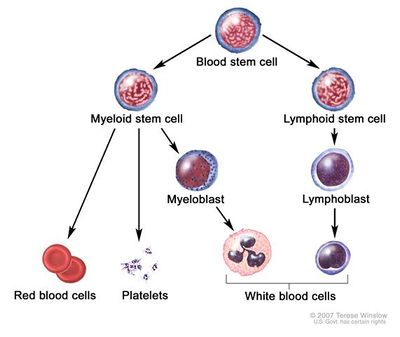Leukemia
This article or area is currently under construction and may only be partially complete. Please come back soon to see the finished work! (16/07/2020)
Original Editor - User:Lucinda hampton
Top Contributors - Lucinda hampton, Kim Jackson, Vidya Acharya, Kapil Narale and Aya Alhindi
Introduction[edit | edit source]
Leukemia is a group of blood-related cancers that affect white blood cell replication in the bone marrow. The abnormal cells crowd out the healthy cells, which affects their ability to fight infection and impedes the production of blood cells.[1]
Pathophysiology[edit | edit source]
Bone marrow is responsible for the making of red blood cells (RBC), white blood cells (WBC) and platelets.
In leukaemia, due to the immature cells or some defect in the cells of the bone marrow, the abnormal and functionless WBC are produced which are unable to fight against the infection and defend the body against foreign substances.
Also, they obstruct the production of other blood cells by dividing quickly and crowding among normal cells.
Leukaemia generally affects either of the two major types of WBC - lymphocytes and granulocytes.
When it arises from:
- Lymphocytes, it is called lymphocytic leukaemia
- Granulocytes, it is called myelogenous or myeloid leukaemia.
Depending upon the type of leukaemia cells the condition is either
- Acute
- Chronic
It occurs more likely in men than in women and older people compared to adults. In children, generally, it occurs before age 10.[2]
Sub Heading 2[edit | edit source]
Sub Heading 3[edit | edit source]
Resources[edit | edit source]
- bulleted list
- x
or
- numbered list
- x
References[edit | edit source]
- ↑ Very well health Leukemia Available from:https://www.verywellhealth.com/leukemia-overview-514157 (last accessed 16.7.2020)
- ↑ Boldsky Leukemia Available from:https://www.boldsky.com/health/disorders-cure/leukaemia-causes-types-symptoms-complications-treatment-prevention-130098.html (last accessed 16.7.2020)







